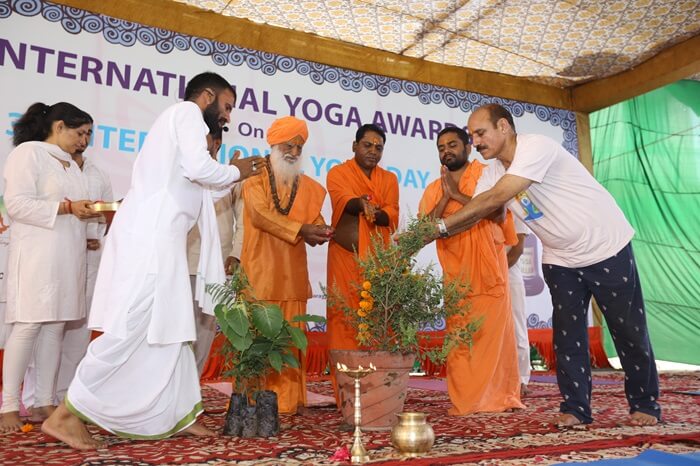We have been witnessing an ever-growing trend of pursuing Yoga Teacher Training in India lately, eventually graduating into a certified International Yoga Teacher. People from all around the world are realising the physical and mental benefits of yoga; to the point that over 36 million individuals from the US alone engage in yoga regularly.
As a result of this demand, the global market for yoga is projected to grow to USD 250.70 billion by 2032 from its current valuation of USD 115.43 billion. We cannot overlook the set of benefits that one can get by pursuing Yoga Teacher Training In India—including cultural immersion, comprehensive curriculum, recognition, and authenticity.
Learn how and why it is worth it to obtain a Yoga Alliance certification from India and become an international yoga teacher.

Why India For Your Yoga Teacher Training?
Yoga originated in India, so learning this ancient cultural way of living in this nation calls for an ethereal experience. Moreover, this long history of cultural and spiritual influences gives this land a sense of authenticity.
In India, you can go with a variety of locations to start your yoga teacher training journey: lush landscapes of Kerala, serene beaches in Goa, or Rishikesh.
That being said, let’s dive deeper into the above.
Rich Yoga Tradition and Cultural Immersion
As mentioned earlier, there is a profound spiritual environment that one can experience by becoming an international yoga teacher in India. This makes the learning process even more surreal and spiritually satisfying.
Visiting India gives people from different walks of life the opportunity to blend themselves with the culture of India, further delving into its heritage. In India, yoga is not merely a set of practices to improve physical and spiritual aspects of life; it is woven into Indian traditional arts, rituals, and festivals. This means yoga has a huge cultural significance in the land of spirituality.
What makes getting an RYT 200 Yoga Teacher certification in India truly unique is the fact that different yoga types are tied to different purposes. For instance, Hatha Yoga emphasises physical postures and breathing techniques, while Bhakti Yoga focuses on devotion to a personal deity. This diversity allows practitioners to explore various paths within the same tradition.
Affordable and High-Quality Training Programs
Another factor that makes pursuing yoga teacher training in India stand out is the cost. Generally, yoga ashrams and institutes offer accommodation and meals along with regular classes.
Understanding Yoga Teacher Certifications in India
To become an international yoga teacher, one needs to have some knowledge about certifications to teach abroad. The majority of Indian programs offer a Yoga Alliance certification recognised worldwide as the gold standard. Thus, you are set up for foundational, advanced classes to become a yoga teacher and also for specialised classes. The certification programs in India help in building career prospects both within India and abroad.

RYT 200 Certification: The First Step
Actually, the RYT 200 course is the entry qualification for any aspiring international yoga teacher who wishes to successfully practice asana, pranayama, meditation, and yogic philosophy. The students are trained through a comprehensive 200-hour course that gives a complete round-off to teach anatomy and teaching methodologies. Most Indian schools offer this as an all-inclusive, immersion-type course. RYT 200 graduates qualify to teach beginner classes anywhere in the world, so it is an excellent place to begin your professional yoga teaching career. This certification enables one not only to teach but also to lay foundational blocks that move people even further on their journey of deep spiritual practice and development.
Yoga Alliance Certification: Your Global Passport
It is often considered the global passport for teaching yoga. Yoga Alliance certification is currently the most recognised worldwide, bringing you credibility to teach in any country. Schools offering yoga teacher training in India are mostly Yoga Alliance accredited, assuring you of a high level of teaching. You can teach yoga in any studio, retreat, or wellness centre around the world with the Yoga Alliance certification. This further enhances your marketability as a yoga teacher and increases access to a global community of yoga professionals who can share knowledge and network. For those seeking a career abroad, this is an important certification.
Finding The Best Yoga School In India
Becoming a good yoga teacher depends on the school you’re opting for. India has various kinds of schools, but not all are alike. Checking the reputation, accreditation, and location of the program selected is always wise. Best schools offer a well-rounded, high-quality education while fully immersing you in the spiritual essence of yoga, so it will be easy for you to meet the yoga teaching requirements in every country of the world.
Reputation and Accreditation
A good reputation and accreditation of the school that would offer you training can be quite influential to your success as an international yoga teacher. Many good schools credited by the Yoga Alliance hold good quality education, which meets global yoga teacher requirements. So, when considering a school for your Yoga Teacher Training In India, research its history, read the reviews of alumni, and make sure that it is accredited by the Yoga Alliance. This accreditation ensures that you are studying standards conforming curricula and will graduate confidently in teaching. The choice of a good school will also avail you of opportunities for good networking relationships and follow-up support after certification, all that you need to push on with your career in teaching.
Location: Rishikesh, Goa, or Kerala?
There are many enormously popular yoga teacher training locations, each offering a different experience.
For an otherworldly feel, there’s nothing like Rishikesh, which is actually the “Yoga Capital of the World”. It is a peaceful backdrop along the Ganges, perfect for meditation and introspection.
Goa is far more laid-back, with yoga opportunities closely complemented by beach life and playful activities. This may suit the bill for an individual who needs to balance work and play.
While Kerala can certainly not afford to downgrade its Ayurvedic inheritance, quiet surroundings with scope for wellness and healing go hand in hand with your training at the same time.
Such a choice will depend upon individual goals and lifestyle choices made since each of these places has its own charm in being uniquely different.
What’s There in Yoga Teacher Training in India?
Enroll in yoga teacher training in India, and you are promised an experience of a lifetime. From the rigorously daily practices to the deeply spiritual teaching, you’ll get to learn everything that lies beneath the postures of yoga. Training programs combine traditional practices with modern techniques. Theory learning is, therefore, balanced with practice. Personal growth, discipline, and deeper spiritual search can be expected during this training journey.

Daily Routine and Intensity
Most programs in India follow a fairly rigorous and intensive schedule in order to totally immerse you in the yogic lifestyle. Early mornings usually begin with asana practice, followed by lectures on yoga philosophy or anatomy. Afternoons are usually scheduled for pranayama, meditation, and teaching practice sessions. The end of the day concludes with evening meditation and reflection. The gruelling routine becomes a basis for enabling the students to prepare themselves with discipline and endurance. One feels challenged on both physical and mental grounds pretty much during the training, though those are very much part of the experience of transformation. Though sometimes demanding, the schedule assists in building up to the level of commitment required to be an international yoga teacher.
Learning Beyond the Mat
Though the physical practice of yoga is quite important, yoga teacher training in India includes equal time spent in understanding beyond the mat. Training programs detail and review well above yogic philosophy in texts such as the Bhagavad Gita and Yoga Sutras, along with modern anatomy and physiology. This ensures that students learn, in addition to how to perform and teach yoga postures, the spiritual, theoretical aspects which enter into a practice. The training will also equip you to deal with the ethics of teaching yoga, its meditation, and a short history of yoga. Such all-round education helps in training yoga teachers who teach the subject with authenticity and provide the student with more than just a physical workout. It’s this depth of knowledge that makes the accredited international yoga teacher different from the rest.
Overcoming Challenges as a New International Yoga Teacher
International teaching can only be accomplished through challenge, and has its ordeals: one faces experience, difference in culture, and confidence. However, by preparing adequately and embracing those trials as opportunities to learn, new teachers can be successful in many different settings. This chapter will offer practical advice on gaining experience and successfully adapting to different cultural contexts while teaching abroad.
Gaining Experience through Volunteering or Teaching Locally
One of the things a new international yoga teacher needs is experience before applying for paid positions. So, the good times to gain this experience can be volunteering at yoga retreats, in some ashrams or in local community centres. Many newly certified teachers begin teaching free classes to their friends or family. If you are in India, then after passing your certification, many yoga schools allow fresh graduates to assist the senior teachers or even conduct beginner classes. Teachings at the local level will give you time to polish your style, gain confidence, and get constructive feedback. These experiences will rejuvenate your teaching skills and give weight to your resume as well when you’re applying to international positions.
Adapting to Different Cultures
Teaching yoga internationally is a lot more than merely technical skills; it is providing knowledge of totally different cultural contexts within different countries. What one country may expect from the instruction provided will differ from another, and thus, a teacher needs to be receptive to these cultural nuances. For instance, whereas yoga is considered deeply spiritual in India, it is considered strictly as a physical activity in Western nations. Understanding these differences will help you design your classes according to the needs of your students. As an international yoga teacher, flexibility in your approach to teaching, as well as respecting local customs and being open to learning from different cultures will make a great difference in your teaching effectiveness and easier transitions into new environments.
The Takeaway
Completing yoga teacher training in India can make one an international yoga teacher; it is a very enriching and transformative journey. The RYT 200 and Yoga Alliance would be good foundations for teaching yoga. Picking the right school and the right location, then immersing yourself in Indian culture to prepare for the challenge of teaching abroad, will certainly help you succeed in teaching yoga. Whether teaching locally or abroad, education in India provides you with the complete spectrum to spread the essence of yoga across the world.
















